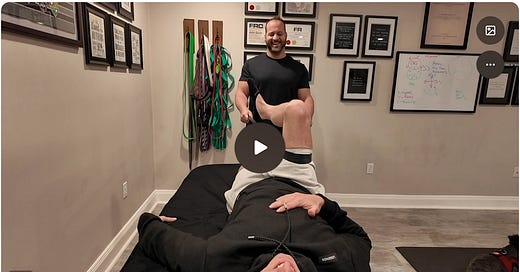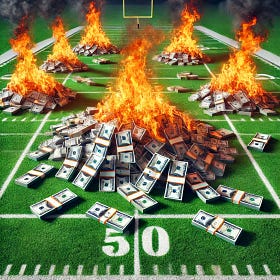Bands in Strength Training Part 3: Scaling into the Clinical Setting
A simple starting strategy for strength practitioners in the clinical setting.

The Neurological Paradigm Ushers us into the Reactive Strength Paradigm
In Part 1 and Part 2, we explored how band tension has become mainstream in strength training. The genesis was when Louie Simmons introduced bands into the absolute strength and speed-strength programming of his powerlifters, it marked what we call the Big Bang of the neurological paradigm in the evolution of strength training. Like the Big Bang created an environment where there is constant expansion of both space and time, this paradigm shift expanded the human nervous system’s ability to generate and output magnitudes of force in conjugation with velocity like nothing we have ever witnessed before. These potent training effects are what propelled his barbell club to wrestle the gorilla that was the sport of powerlifting and pin it to the mat.
The Neurological Training Paradigm Has Sown the Seeds of the Reactive Strength Problem
This rapid expansion of athletes' neurology has pushed them beyond the threshold of the edge of chaos at the level of competition—into an asymmetry where their neurology is outputting more than their biology can transmit, resulting in reactive strength injuries.1 It is safe to say that the only constraint on neurological scaling is biological tissue—the bottom-up element of our definition of reactive strength.
In other words, this neurological-biological-asymmetry has rapidly ushered in the reactive strength training paradigm inflection point, where the reality is that if strength practitioners want to thrive in this chaotic new paradigm, adopting our definition of this special strength is the prerequisite.
Lou Loves It
Having known Lou personally as both an innovative disruptor and one of the most accomplished strength coach-athletes of all time, we can confidently say he would have relished that his barbell club ushered us into this new paradigm. Through their skin-in-the-game training work and success in violently pinning the gorilla of powerlifting to the mat, they ushered in an era where bands are commonplace in the training of absolute strength and speed strength.
Welcome to 2025: The Reactive Strength Paradigm
In 2025, bands have become commonplace for strength practitioners in the weight room, often applied to lifts in ways reminiscent of Louie’s original strategy.2 What might seem like a minor innovation has triggered profound and exponential systemic effects, embodying the principle of sensitive dependence on initial conditions. In chaos theory, this is the butterfly effect: a small change that can amplify a system to the edge of chaos.
Ilya Prigogine’s work enables us to know that when the system in question is the human athlete—a dissipative structure who is performing self-propagating training work—that chaos has the potential to reorganize into a new and higher order. That order, as we’ve discussed extensively, is a scaled-up neurological network of absolute strength.
For those unacquainted with chaos theory: welcome to the chaos of the reactive strength paradigm. Don’t fight it, that’s a game you won’t win—embrace it. It is more fun to fight to stay on the edge where we get to see the highest levels of order emerge at the level of adaption than to run to the hills for perceived safety.
Today’s reality is strength practitioners in the weight room are having athletes perform training work that stimulates the neurology to be virtually unconstrained in scaling—except, of course, by the connective tissue’s limitations in transmitting such magnitudes and velocities of force. Those limitations or what term at Absolute as biological bottlenecks.3 They’re not a bug—they’re the next frontier, which is 2025, and the current reactive strength paradigm.
Drop the Theraguns & Grab a Band
Louie would often quote Rodney Piper: "As soon as you know all the answers to the test, the questions are changed." Clinical practitioners are lagging behind the innovation of utilizing bands in their work.4 As a consequence, the bottom-up scaling of biological connective tissue isn’t keeping pace with the rapid neurological scaling occurring in the weight room. This disparity creates biological bottlenecks, where force accumulates in suboptimal tissues instead of being effectively transmitted. At the level of competition, this accumulation causes catastrophic tissue failures where the end result is blown up connective tissue.
The NFL’s Billion Dollar Reactive Strength Problem illustrates this issue systematically, as, sadly, we see new catastrophic reactive strength injuries every week. Even minor, grade one or two injuries act as landmines sensitive to any force transmission just waiting to detonate. Strength coaches who have adopted our definition of reactive strength are acutely aware of these dynamic force transmission risks, and this knowledge is a constant, low-level psychological stressor—like the dripping of water that is known as Chinese water torture as they watch the athletes they are responsible for knowing the bottom up element of reactive strength isn’t at Point B. Each step they take could lead to the detonation of connective tissue—and oftentimes does.
For the field of strength training to grow its way out of this stagnation, clinical practitioners must step up and address this asymmetry to better support athletes, the strength coaches in the weight room and mitigate these reactive strength injuries. First step drop the theraguns and get yourself band.
Making Waves in the Clinic
Just like Louie wasn’t afraid to look like a fool and understood that failure is just feedback for solving complex problems, we had zero hesitation about bringing bands into the clinic setting. Did we drop our theraguns? No, because we never would use those illogical and lazy feel-good gimmicks to buzz the booboo to begin with. We’re in the business of propelling athletes out of stagnation, not handing out participation trophies to their soft tissue booboos.
Understand: Band resistance goes beyond just external resistance—the nervous system encodes it as tissue resonance. This realization showed us that when bands are applied with a biological-centric training intent rather than a purely neurocentric one, they hold the potential to revolutionize clinical outcomes. Subscriber feedback reinforces this potential: what begins as small ripples in the clinic can amplify into waves of connective tissue adaptation—you know where all the biological bottlenecks are in our definition of reactive strength.
Take the “Risk”
If you’re a clinic operator who isn’t using bands yet, it’s time to stop hiding behind your theragun. Don’t worry—we know readers of this publication are far too advanced to own one (but if you do, maybe reconsider your life choices—seriously). Instead, join us in taking a real “risk”—by actually loading the biological stress-responsive connective tissue. You’ll quickly understand that “risk” is the wrong word. Applying band tension in the clinic isn’t just effective—it’s a lethal weapon against stagnation in sport and the ever-amplifying reactive strength problem.
Bands In The Clinic Video: A Starting Strategy
If you are not utilizing bands in the clinic we want to provide you with a simple starting strategy to get you to go from zero to one—as once you start moving in this direction you’ll amplify rapidly, recall the butterfly effect.
Keep reading with a 7-day free trial
Subscribe to Absolute: The Art and Science of Human Performance to keep reading this post and get 7 days of free access to the full post archives.







